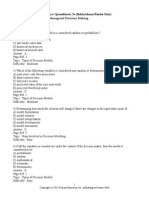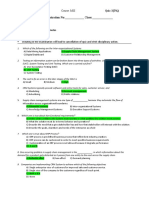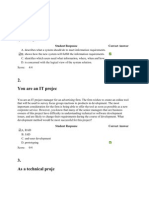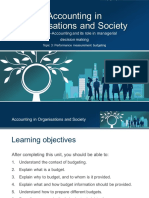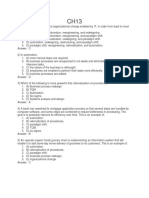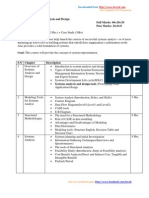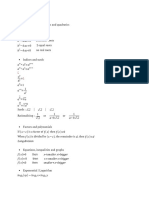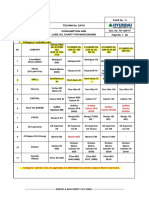Chapter 9 Test Bank 2
Chapter 9 Test Bank 2
Uploaded by
Nguyễn Thị Ngọc HânCopyright:
Available Formats
Chapter 9 Test Bank 2
Chapter 9 Test Bank 2
Uploaded by
Nguyễn Thị Ngọc HânOriginal Title
Copyright
Available Formats
Share this document
Did you find this document useful?
Is this content inappropriate?
Copyright:
Available Formats
Chapter 9 Test Bank 2
Chapter 9 Test Bank 2
Uploaded by
Nguyễn Thị Ngọc HânCopyright:
Available Formats
lOMoARcPSD|8146737
Chapter 9 - Test bank
Management Information Systems (Lebanese International University )
StuDocu is not sponsored or endorsed by any college or university
Downloaded by Pham Quynh (phamquynh.170101@gmail.com)
lOMoARcPSD|8146737
Management Information Systems, 14e (Laudon)
Chapter 9 Achieving Operational Excellence and Customer Intimacy: Enterprise
Applications
1) From your reading of the chapter's opening case, ACH Food Companies implemented new
information systems in order to achieve which of the following business objectives?
A) customer and supplier intimacy
B) operational excellence
C) survival
D) improved decision making
E) new products and services
Answer: B
Page Ref: 347-348
Difficulty: Difficult
AACSB: Analytical thinking
CASE: Analysis in terms of categorize
LO: 9.1: How do enterprise systems help businesses achieve operational excellence?
2) A suite of integrated software modules for finance and accounting, human resources,
manufacturing and production, and sales and marketing that allows data to be used by multiple
functions and business processes best describes
A) process management software.
B) ERP systems.
C) groupware.
D) application software.
E) supply chain management systems.
Answer: B
Page Ref: 350
Difficulty: Moderate
AACSB: Information technology
CASE: Comprehension
LO: 9.1: How do enterprise systems help businesses achieve operational excellence?
3) Enterprise software is built around thousands of predefined business processes that reflect
A) the firm's organization.
B) industry goals.
C) best practices.
D) cutting edge workflow analyses.
E) the firm's culture.
Answer: C
Page Ref: 351
Difficulty: Moderate
AACSB: Information technology
CASE: Comprehension
LO: 9.1: How do enterprise systems help businesses achieve operational excellence?
1
Copyright © 2016 Pearson Education, Inc.
Downloaded by Pham Quynh (phamquynh.170101@gmail.com)
lOMoARcPSD|8146737
4) Which of the following is not true about enterprise systems?
A) Enterprise systems help firms respond rapidly to customer requests for information or
products.
B) Enterprise system data have standardized definitions and formats that are accepted by the
entire organization.
C) Enterprise software is expressly built to allow companies to mimic their unique business
practices.
D) Enterprise software includes analytical tools to evaluate overall organizational performance.
E) Enterprise systems provide firmwide information to help managers make better decisions.
Answer: C
Page Ref: 352-353
Difficulty: Moderate
AACSB: Analytical thinking
CASE: Evaluation in terms of assess
LO: 9.1: How do enterprise systems help businesses achieve operational excellence?
5) You have been asked to implement enterprise software for a manufacturer of kitchen
appliances. What is the first step you should take?
A) Rewrite the software to support the way the company's business processes work.
B) Select the business processes you wish to automate.
C) Map the company's business processes to the software's business processes.
D) Map the software's business processes to the company's business processes.
E) Select the functions of the system you wish to use.
Answer: E
Page Ref: 351
Difficulty: Moderate
AACSB: Analytical thinking
CASE: Evaluation in terms of assess
LO: 9.1: How do enterprise systems help businesses achieve operational excellence?
6) When tailoring a particular aspect of a system to the way a company does business, enterprise
software can provide the company with
A) configuration tables.
B) Web services.
C) data dictionaries.
D) middleware.
E) customized plug-ins.
Answer: A
Page Ref: 351
Difficulty: Moderate
AACSB: Information technology
CASE: Comprehension
LO: 9.1: How do enterprise systems help businesses achieve operational excellence?
2
Copyright © 2016 Pearson Education, Inc.
Downloaded by Pham Quynh (phamquynh.170101@gmail.com)
lOMoARcPSD|8146737
7) In order to achieve maximum benefit from an enterprise software package, a business
A) customizes the software to match all of its business processes.
B) uses only the processes in the software that match its own processes.
C) changes the way it works to match the software's business processes.
D) selects only the software that best matches its existing business processes.
E) retains legacy systems that best work with the software.
Answer: C
Page Ref: 352
Difficulty: Moderate
AACSB: Information technology
CASE: Evaluation in terms of assess
LO: 9.1: How do enterprise systems help businesses achieve operational excellence?
8) ________ systems are based on a suite of software models used to support business activities
across the firm.
A) Global
B) Organizational
C) Supply chain
D) Product differentiation
E) Enterprise
Answer: E
Page Ref: 351
Difficulty: Moderate
AACSB: Information technology
CASE: Comprehension
LO: 9.1: How do enterprise systems help businesses achieve operational excellence?
9) Enterprise systems include analytical tools.
Answer: TRUE
Page Ref: 352
Difficulty: Moderate
AACSB: Information technology
CASE: Comprehension
LO: 9.1: How do enterprise systems help businesses achieve operational excellence?
10) An enterprise system helps reduce redundant business processes.
Answer: FALSE
Page Ref: 352
Difficulty: Moderate
AACSB: Information technology
CASE: Comprehension
LO: 9.1: How do enterprise systems help businesses achieve operational excellence?
3
Copyright © 2016 Pearson Education, Inc.
Downloaded by Pham Quynh (phamquynh.170101@gmail.com)
lOMoARcPSD|8146737
11) Identify and describe three major enterprise applications.
Answer: Enterprise systems, customer relationship management, and supply chain management
are three enterprise applications. Enterprise systems are based on a suite of integrated software
modules and a common central database. Enterprise systems utilize enterprise software to
support financial and accounting, human resources, manufacturing and production, and sales and
marketing processes. Enterprise systems provide many benefits including an enterprise-enabled
organization, improved management reporting and decision making, a unified information
systems technology platform, and more efficient operations and customer-driven business
processes.
Supply chain management systems help an organization better manage its supply chain,
including planning, sourcing, making, delivering, and returning items. Supply chain management
software can be categorized as a supply chain planning system or as a supply chain execution
system. A supply chain planning system enables a firm to generate demand forecasts for a
product and to develop sourcing and manufacturing plans for that product. A supply chain
execution system manages the flow of products through distribution centers and warehouses to
ensure that products are delivered to the right locations in the most efficient manner. Supply
chain management benefits include improved customer service and responsiveness, cost
reduction, and cash utilization.
Customer relationship management systems help firms maximize the benefits of their customer
assets. These systems capture and consolidate data from all over the organization and then
distribute the results to various systems and customer touch points across the enterprise.
Customer relationship management systems can be classified as operational or as analytical.
Operational CRM refers to customer-facing applications, such as sales force automation, call
center and customer service support, and marketing automation. Analytical CRM refers to
customer relationship management applications dealing with the analysis of customer data to
provide information for improving business performance. Benefits include increased customer
satisfaction, reduced direct marketing costs, more effective marketing, and lower costs for
customer acquisition and retention.
Page Ref: 350-372
Difficulty: Moderate
AACSB: Analytical thinking
CASE: Analysis in terms of summarize
LO: 9.1: How do enterprise systems help businesses achieve operational excellence?
4
Copyright © 2016 Pearson Education, Inc.
Downloaded by Pham Quynh (phamquynh.170101@gmail.com)
lOMoARcPSD|8146737
12) Identify at least four benefits and four challenges of enterprise systems.
Answer: Benefits include: increasing operational efficiency; providing firmwide information to
help decision making; standardized business processes; greater responsiveness to customer
needs; greater accuracy in fulfilling product demand; reduction of inventory and inventory costs;
reduction in order-to-delivery time; improving business processes; removing redundant
processes and systems; lowering costs through centralized processing; and improved decision
making. Challenges include: the expense of the software and related costs; the time required for
implementation; deep-seated technological changes required, the deep-seated organizational
changes required; overcoming organizational resistance; switching costs; data cleansing work
required.
Page Ref: 353-372
Difficulty: Moderate
AACSB: Analytical thinking
CASE: Evaluation in terms of assess
LO: 9.1: How do enterprise systems help businesses achieve operational excellence?
13) You have been hired by Santori, Inc., a small company that imports and distributes an Italian
sparkling water. The company is interested in what benefits an enterprise system would bring.
Would an enterprise system be appropriate for this company? What steps would you take in
determining this?
Answer: An enterprise system may be too expensive, although there are enterprise software
packages that are available to smaller companies. A hosted enterprise application might be the
most economical way to implement an enterprise system. To determine whether this would be
beneficial to Santori, I would first look at their existing business processes. It would be ideal to
determine if their efficiency meets benchmarks in their industry and allows them to be
competitive with other businesses in their niche. Then I would review existing hosted
applications to see how the applications business processes matched up with Santori's. It would
be important to compare the costs of instituting new business processes with the benefits and
cost savings.
Page Ref: 349-372
Difficulty: Difficult
AACSB: Analytical thinking
CASE: Synthesis in terms of devising
LO: 9.1: How do enterprise systems help businesses achieve operational excellence?
5
Copyright © 2016 Pearson Education, Inc.
Downloaded by Pham Quynh (phamquynh.170101@gmail.com)
lOMoARcPSD|8146737
14) Supply chain complexity and scale increases when firms
A) move to globalization.
B) manage the procurement, manufacturing, and distribution functions themselves.
C) outsource more labor.
D) modify their existing workflows to comply with supply-chain management systems.
E) develop products and services that coordinate with many firms and suppliers.
Answer: E
Page Ref: 353
Difficulty: Difficult
AACSB: Analytical thinking
CASE: Analysis in terms of appraise
LO: 9.2: How do supply chain management systems coordinate planning, production, and
logistics with suppliers?
15) A network of organizations and business processes for procuring raw materials, transforming
these materials into intermediate and finished products, and distributing the finished products to
customers is called a
A) distribution channel.
B) supply chain.
C) value chain.
D) marketing channel.
E) information system.
Answer: B
Page Ref: 353
Difficulty: Moderate
AACSB: Reflective thinking
CASE: Comprehension
LO: 9.2: How do supply chain management systems coordinate planning, production, and
logistics with suppliers?
16) Components or parts of finished products are referred to as
A) upstream materials.
B) raw materials.
C) secondary products.
D) intermediate products.
E) mid-chain products.
Answer: D
Page Ref: 353
Difficulty: Moderate
AACSB: Reflective thinking
CASE: Comprehension
LO: 9.2: How do supply chain management systems coordinate planning, production, and
logistics with suppliers?
6
Copyright © 2016 Pearson Education, Inc.
Downloaded by Pham Quynh (phamquynh.170101@gmail.com)
lOMoARcPSD|8146737
17) A company's suppliers, supplier's suppliers, and the processes for managing relationships
with them is the
A) supplier's internal supply chain.
B) external supply chain.
C) upstream portion of the supply chain.
D) downstream portion of the supply chain.
E) onstream portion of the supply chain.
Answer: C
Page Ref: 354
Difficulty: Moderate
AACSB: Reflective thinking
CASE: Comprehension
LO: 9.2: How do supply chain management systems coordinate planning, production, and
logistics with suppliers?
18) A company's organizations and processes for distributing and delivering products to the final
customers is the
A) supplier's internal supply chain.
B) external supply chain.
C) upstream portion of the supply chain.
D) downstream portion of the supply chain.
E) onstream portion of the supply chain.
Answer: D
Page Ref: 354
Difficulty: Moderate
AACSB: Reflective thinking
CASE: Comprehension
LO: 9.2: How do supply chain management systems coordinate planning, production, and
logistics with suppliers?
19) If manufacturers had perfect information, they could implement a
A) hyper-efficient strategy.
B) frictionless strategy.
C) streamlined strategy.
D) bullwhip strategy.
E) just-in-time strategy.
Answer: E
Page Ref: 355
Difficulty: Moderate
AACSB: Analytical thinking
CASE: Analysis in terms of appraise
LO: 9.2: How do supply chain management systems coordinate planning, production, and
logistics with suppliers?
7
Copyright © 2016 Pearson Education, Inc.
Downloaded by Pham Quynh (phamquynh.170101@gmail.com)
lOMoARcPSD|8146737
20) Why is overstocking warehouses not an effective solution for a problem of low availability?
A) It does not speed product time to market.
B) It is an inefficient use of raw materials.
C) It increases sales costs.
D) It increases inventory costs.
E) It lowers fill rate.
Answer: D
Page Ref: 355
Difficulty: Moderate
AACSB: Analytical thinking
CASE: Analysis in terms of appraise
LO: 9.2: How do supply chain management systems coordinate planning, production, and
logistics with suppliers?
21) Which of the following traditional solutions enables manufacturers to deal with uncertainties
in the supply chain?
A) safety stock
B) continuous replenishment
C) just-in-time strategies
D) demand planning
E) perfect information
Answer: A
Page Ref: 355
Difficulty: Moderate
AACSB: Reflective thinking
CASE: Comprehension
LO: 9.2: How do supply chain management systems coordinate planning, production, and
logistics with suppliers?
22) A scheduling system for minimizing inventory by having components arrive exactly at the
moment they are needed and finished goods shipped as soon as they leave the assembly line best
describes a ________ strategy.
A) just-in-time
B) frictionless
C) bullwhip
D) safety-stock
E) streamlined
Answer: A
Page Ref: 355
Difficulty: Moderate
AACSB: Information technology
CASE: Comprehension
LO: 9.2: How do supply chain management systems coordinate planning, production, and
logistics with suppliers?
8
Copyright © 2016 Pearson Education, Inc.
Downloaded by Pham Quynh (phamquynh.170101@gmail.com)
lOMoARcPSD|8146737
23) A distortion of information about the demand for a product as it passes from one entity to the
next across the supply chain is called the ________ effect.
A) network
B) bullwhip
C) ripple
D) whirlpool
E) diffraction
Answer: B
Page Ref: 355
Difficulty: Easy
AACSB: Application of knowledge
CASE: Comprehension
LO: 9.2: How do supply chain management systems coordinate planning, production, and
logistics with suppliers?
24) Supply chain software can be classified as either supply chain ________ systems or supply
chain ________ systems.
A) push; pull
B) demand; continual
C) upstream; downstream
D) planning; execution
E) maintenance; development
Answer: D
Page Ref: 355-358
Difficulty: Moderate
AACSB: Information technology
CASE: Comprehension
LO: 9.2: How do supply chain management systems coordinate planning, production, and
logistics with suppliers?
25) Systems that enable a firm to generate demand forecasts for a product and to develop
sourcing and manufacturing plans for that product best describes supply chain ________
systems.
A) demand
B) delivery
C) optimization
D) execution
E) planning
Answer: E
Page Ref: 355
Difficulty: Moderate
AACSB: Information technology
CASE: Comprehension
LO: 9.2: How do supply chain management systems coordinate planning, production, and
logistics with suppliers?
9
Copyright © 2016 Pearson Education, Inc.
Downloaded by Pham Quynh (phamquynh.170101@gmail.com)
lOMoARcPSD|8146737
26) Supply chain planning systems perform all of the following functions except
A) establish inventory levels for raw materials and finished goods.
B) identify the transportation mode to use for product delivery.
C) determine where to store finished goods.
D) determine how much product to manufacture in a given time period.
E) track the physical status of goods.
Answer: E
Page Ref: 355-356
Difficulty: Moderate
AACSB: Information technology
CASE: Comprehension
LO: 9.2: How do supply chain management systems coordinate planning, production, and
logistics with suppliers?
27) Which supply chain planning function determines how much product is needed to satisfy all
customer demands?
A) distribution management
B) replenishment planning
C) demand planning
D) order planning
E) customer planning
Answer: C
Page Ref: 356
Difficulty: Moderate
AACSB: Information technology
CASE: Comprehension
LO: 9.2: How do supply chain management systems coordinate planning, production, and
logistics with suppliers?
28) Supply chain ________ systems manage the flow of products through distribution centers
and warehouses to ensure that products are delivered to the right locations in the most efficient
manner.
A) demand
B) delivery
C) planning
D) execution
E) optimization
Answer: D
Page Ref: 358
Difficulty: Moderate
AACSB: Information technology
CASE: Comprehension
LO: 9.2: How do supply chain management systems coordinate planning, production, and
logistics with suppliers?
10
Copyright © 2016 Pearson Education, Inc.
Downloaded by Pham Quynh (phamquynh.170101@gmail.com)
lOMoARcPSD|8146737
29) Capabilities of supply chain execution systems would not include
A) identifying the optimal transportation mode.
B) tracking the flow of finished goods.
C) managing materials.
D) managing warehouse operations.
E) managing the financial information involving all parties.
Answer: A
Page Ref: 358-359
Difficulty: Moderate
AACSB: Information technology
CASE: Comprehension
LO: 9.2: How do supply chain management systems coordinate planning, production, and
logistics with suppliers?
30) From your reading of the Scott's Miracle-Gro case study, the company implemented SAP
and JDA enterprise and supply chain planning systems to solve what problems?
A) lack of brand recognition
B) lack of coordination among production facilities
C) poor supply chain visibility for management
D) shoddy record-keeping
E) coordination issues caused by the merger of Scott's and MiracleGro
Answer: E
Page Ref: 357-358
Difficulty: Moderate
AACSB: Analytical thinking
CASE: Evaluation in terms of assess
LO: 9.2: How do supply chain management systems coordinate planning, production, and
logistics with suppliers?
31) A supply chain driven by actual customer orders or purchases follows a ________ model.
A) pull-based
B) build-to-stock
C) push-based
D) replenishment-driven
E) optimized
Answer: A
Page Ref: 360
Difficulty: Moderate
AACSB: Information technology
CASE: Comprehension
LO: 9.2: How do supply chain management systems coordinate planning, production, and
logistics with suppliers?
11
Copyright © 2016 Pearson Education, Inc.
Downloaded by Pham Quynh (phamquynh.170101@gmail.com)
lOMoARcPSD|8146737
32) A build-to-order supply-chain model is also called a ________ model.
A) supply-based
B) demand-driven
C) replenishment-driven
D) push-based
E) market-driven
Answer: B
Page Ref: 360
Difficulty: Moderate
AACSB: Information technology
CASE: Comprehension
LO: 9.2: How do supply chain management systems coordinate planning, production, and
logistics with suppliers?
33) Concurrent supply chains are made possible by which technology?
A) ERP systems
B) the Internet
C) supply-chain management systems
D) just-in-time supply-chain technologies
E) extranets
Answer: B
Page Ref: 360
Difficulty: Easy
AACSB: Information technology
CASE: Comprehension
LO: 9.2: How do supply chain management systems coordinate planning, production, and
logistics with suppliers?
34) The business value of an effective supply chain management system includes all of the
following except
A) faster time to market.
B) cost reduction.
C) supply matched to demand.
D) improved delivery service.
E) increased inventory levels.
Answer: D
Page Ref: 361
Difficulty: Moderate
AACSB: Analytical thinking
CASE: Evaluation in terms of assess
LO: 9.2: How do supply chain management systems coordinate planning, production, and
logistics with suppliers?
12
Copyright © 2016 Pearson Education, Inc.
Downloaded by Pham Quynh (phamquynh.170101@gmail.com)
lOMoARcPSD|8146737
35) The bullwhip effect is countered by
A) globalization.
B) disintermediation.
C) implementing an SCM.
D) reducing information uncertainty.
E) product differentiation.
Answer: D
Page Ref: 355
Difficulty: Moderate
AACSB: Reflective thinking
CASE: Comprehension
LO: 9.2: How do supply chain management systems coordinate planning, production, and
logistics with suppliers?
36) As they move through the supply chain, ________ are transformed into finished products
and shipped to retailers and customers.
A) raw materials
B) intermediate products
C) basic products
D) natural resources
E) nascent products
Answer: A
Page Ref: 353
Difficulty: Easy
AACSB: Reflective thinking
CASE: Comprehension
LO: 9.2: How do supply chain management systems coordinate planning, production, and
logistics with suppliers?
37) The total time it takes to complete a business process, from start to finish, is called its
________ time.
A) development
B) cycle
C) fulfillment
D) service
E) actualization
Answer: B
Page Ref: 353
Difficulty: Moderate
AACSB: Reflective thinking
CASE: Comprehension
LO: 9.2: How do supply chain management systems coordinate planning, production, and
logistics with suppliers?
13
Copyright © 2016 Pearson Education, Inc.
Downloaded by Pham Quynh (phamquynh.170101@gmail.com)
lOMoARcPSD|8146737
38) A company having difficulty with timely delivery of parts to its manufacturing plants should
implement a supply chain ________ system.
A) execution
B) planning
C) optimization
D) management
E) touch point
Answer: A
Page Ref: 358
Difficulty: Moderate
AACSB: Information technology
CASE: Comprehension
LO: 9.2: How do supply chain management systems coordinate planning, production, and
logistics with suppliers?
39) Supply chain management systems are a type of enterprise system.
Answer: FALSE
Page Ref: 355
Difficulty: Moderate
AACSB: Application of knowledge
CASE: Comprehension
LO: 9.2: How do supply chain management systems coordinate planning, production, and
logistics with suppliers?
40) The upstream portion of the supply chain consists of the organizations and processes for
distributing and delivering products to the final customers.
Answer: FALSE
Page Ref: 354
Difficulty: Moderate
AACSB: Reflective thinking
CASE: Comprehension
LO: 9.2: How do supply chain management systems coordinate planning, production, and
logistics with suppliers?
41) Supply chain inefficiencies can waste as much as 25 percent of a company's operating costs.
Answer: TRUE
Page Ref: 355
Difficulty: Moderate
AACSB: Reflective thinking
CASE: Comprehension
LO: 9.2: How do supply chain management systems coordinate planning, production, and
logistics with suppliers?
14
Copyright © 2016 Pearson Education, Inc.
Downloaded by Pham Quynh (phamquynh.170101@gmail.com)
lOMoARcPSD|8146737
42) Safety stock acts as a buffer for the lack of flexibility in the supply chain.
Answer: TRUE
Page Ref: 355
Difficulty: Moderate
AACSB: Reflective thinking
CASE: Comprehension
LO: 9.2: How do supply chain management systems coordinate planning, production, and
logistics with suppliers?
43) The bullwhip effect describes consistency and continuity in demand for a product as it passes
from one entity to the next across the supply chain.
Answer: FALSE
Page Ref: 355
Difficulty: Moderate
AACSB: Reflective thinking
CASE: Comprehension
LO: 9.2: How do supply chain management systems coordinate planning, production, and
logistics with suppliers?
44) Supply chain execution systems enable the firm to generate demand forecasts for a product
and to develop sourcing and manufacturing plans for that product.
Answer: FALSE
Page Ref: 358
Difficulty: Moderate
AACSB: Information technology
CASE: Comprehension
LO: 9.2: How do supply chain management systems coordinate planning, production, and
logistics with suppliers?
45) Before the Internet, supply chain coordination was hampered by the difficulties of making
information flow smoothly among different internal supply chain processes.
Answer: TRUE
Page Ref: 359
Difficulty: Moderate
AACSB: Reflective thinking
CASE: Comprehension
LO: 9.2: How do supply chain management systems coordinate planning, production, and
logistics with suppliers?
46) Inefficiencies in a supply chain are primarily caused by inaccurate information.
Answer: TRUE
Page Ref: 354
Difficulty: Easy
AACSB: Analytical thinking
CASE: Evaluation in terms of assess
LO: 9.2: How do supply chain management systems coordinate planning, production, and
logistics with suppliers?
15
Copyright © 2016 Pearson Education, Inc.
Downloaded by Pham Quynh (phamquynh.170101@gmail.com)
lOMoARcPSD|8146737
47) In a push-based model of SCM systems, actual customer orders or purchases trigger events
in the supply chain.
Answer: FALSE
Page Ref: 360
Difficulty: Moderate
AACSB: Reflective thinking
CASE: Comprehension
LO: 9.2: How do supply chain management systems coordinate planning, production, and
logistics with suppliers?
48) In a pull-based model of SCM systems, production master schedules are based on forecasts
of demand for products.
Answer: FALSE
Page Ref: 360
Difficulty: Moderate
AACSB: Reflective thinking
CASE: Comprehension
LO: 9.2: How do supply chain management systems coordinate planning, production, and
logistics with suppliers?
49) Walmart is an example of a push-based model.
Answer: FALSE
Page Ref: 360
Difficulty: Moderate
AACSB: Reflective thinking
CASE: Comprehension
LO: 9.2: How do supply chain management systems coordinate planning, production, and
logistics with suppliers?
50) Total supply chain costs represent the majority of operating expenses for many businesses
and in some industries approach 75 percent of the total operating budget.
Answer: TRUE
Page Ref: 361
Difficulty: Moderate
AACSB: Reflective thinking
CASE: Comprehension
LO: 9.2: How do supply chain management systems coordinate planning, production, and
logistics with suppliers?
16
Copyright © 2016 Pearson Education, Inc.
Downloaded by Pham Quynh (phamquynh.170101@gmail.com)
lOMoARcPSD|8146737
51) Identify two classifications for supply chain software. For each classification, identify five
capabilities.
Answer: Supply chain planning systems and supply chain execution systems are two
classifications for supply chain software. Supply chain planning systems enable a firm to
generate demand forecasts for a product and develop sourcing and manufacturing plans for that
product. Capabilities include order planning, advanced scheduling and manufacturing planning,
demand planning, distribution planning, and transportation planning. Supply chain execution
systems manage the flow of products through distribution centers and warehouses to ensure that
products are delivered to the right locations. Capabilities include order commitments, final
production, replenishment, distribution management, and reverse distribution.
Page Ref: 355-358
Difficulty: Moderate
AACSB: Analytical thinking
CASE: Analysis in terms of summarize
LO: 9.2: How do supply chain management systems coordinate planning, production, and
logistics with suppliers?
52) What additional complexities are faced in global supply chains? How does the Internet help
in managing global supply chains?
Answer: Global supply chains typically span greater geographic distances and time differences
than domestic supply chains and have participants from a number of different countries.
Although the purchase price of many goods might be lower abroad, there are often additional
costs for transportation, inventory, and local taxes or fees. Performance standards may vary from
region to region or from nation to nation. Supply chain management may need to reflect foreign
government regulations and cultural differences. All of these factors impact how a company
takes orders, plans distribution, organizes warehousing, and manages inbound and outbound
logistics throughout the global markets it services. The Internet helps companies manage many
aspects of their global supply chains, including sourcing, transportation, communications, and
international finance. As goods are being sourced, produced, and shipped, communication is
required among retailers, manufacturers, contractors, agents, and logistics providers. With
Internet technology, supply chain members communicate through a Web-based system. Firms
use intranets to improve coordination among their internal supply chain processes, and they use
extranets to coordinate supply chain processes shared with their business partners.
Page Ref: 359-360
Difficulty: Moderate
AACSB: Analytical thinking
CASE: Evaluation in terms of assess
LO: 9.2: How do supply chain management systems coordinate planning, production, and
logistics with suppliers?
17
Copyright © 2016 Pearson Education, Inc.
Downloaded by Pham Quynh (phamquynh.170101@gmail.com)
lOMoARcPSD|8146737
53) Identify two supply chain models. Which is better?
Answer: Push-based and pull-based models were discussed in the textbook. Push-based refers to
a supply chain driven by production master schedules based on forecasts or best guesses of
demand for products. Pull-based refers to a supply chain driven by actual customer orders or
purchases so that members of the supply chain produce and deliver only what customers have
ordered. Pull-based models are better.
Page Ref: 360
Difficulty: Easy
AACSB: Analytical thinking
CASE: Evaluation in terms of assess
LO: 9.2: How do supply chain management systems coordinate planning, production, and
logistics with suppliers?
54) Plant Away is an Oregon-based retailer and distributor of trees and shrubs. They have
hundreds of smaller nurseries based around the country that grow the plant stock. The majority
of their business is conducted online. Consumers purchase typically small quantities of products
online and Plant Away coordinates the shipping from the most appropriate nursery. What unique
problems might you anticipate they have in their supply chain? What might remedy these
problems?
Answer: Typical problems in supply chains arise from unforeseeable events. In a plant nursery,
variations in the weather, growing season, plant diseases, crop output would be uncertainties.
Other problems might be interstate regulations governing plants allowed in different states, and
making sure plants survive and are healthy during transportation. It would be very important to
have up-to-date forecasting of the weather or growing seasons that could anticipate possible
problems, and analyze and determine the best transportation routes.
Page Ref: 352-361
Difficulty: Difficult
AACSB: Analytical thinking
CASE: Synthesis in terms of devising
LO: 9.2: How do supply chain management systems coordinate planning, production, and
logistics with suppliers?
55) A ________ is a method of interaction with a customer, such as telephone or customer
service desk.
A) point of presence
B) touch point
C) sales point
D) client channel
E) point of service
Answer: B
Page Ref: 362
Difficulty: Moderate
AACSB: Reflective thinking
CASE: Comprehension
LO: 9.3: How do customer relationship management systems help firms achieve customer
intimacy?
18
Copyright © 2016 Pearson Education, Inc.
Downloaded by Pham Quynh (phamquynh.170101@gmail.com)
lOMoARcPSD|8146737
56) Which of the following would not be considered a contact point?
A) e-mail
B) Web site
C) intranet
D) retail store
E) Facebook
Answer: C
Page Ref: 362
Difficulty: Moderate
AACSB: Information technology
CASE: Comprehension
LO: 9.3: How do customer relationship management systems help firms achieve customer
intimacy?
57) ________ modules use many of the same data, tools, and systems as CRM to enhance
collaboration between a company and its selling partners.
A) SCM
B) SFA
C) ERM
D) DRM
E) PRM
Answer: E
Page Ref: 362
Difficulty: Moderate
AACSB: Information technology
CASE: Comprehension
LO: 9.3: How do customer relationship management systems help firms achieve customer
intimacy?
58) ________ modules deal with issues such as setting objectives, employee performance
management, and performance-based compensation.
A) SCM
B) SFA
C) ERM
D) DRM
E) PRM
Answer: C
Page Ref: 363
Difficulty: Moderate
AACSB: Information technology
CASE: Comprehension
LO: 9.3: How do customer relationship management systems help firms achieve customer
intimacy?
19
Copyright © 2016 Pearson Education, Inc.
Downloaded by Pham Quynh (phamquynh.170101@gmail.com)
lOMoARcPSD|8146737
59) Customer relationship management systems typically provide software and online tools for
sales, customer service, and
A) marketing.
B) account management.
C) advertising.
D) public relations.
E) human resources.
Answer: A
Page Ref: 362-363
Difficulty: Moderate
AACSB: Information technology
CASE: Comprehension
LO: 9.3: How do customer relationship management systems help firms achieve customer
intimacy?
60) SFA modules in CRM systems would provide tools for
A) assigning and managing customer service requests.
B) capturing prospect and customer data.
C) identifying profitable and unprofitable customers.
D) managing sales prospect and contact information.
E) employee performance management.
Answer: D
Page Ref: 363
Difficulty: Easy
AACSB: Information technology
CASE: Comprehension
LO: 9.3: How do customer relationship management systems help firms achieve customer
intimacy?
61) CRM systems help businesses obtain which business objective?
A) survival
B) operational excellence
C) new products and services
D) improved decision making
E) customer and supplier intimacy
Answer: E
Page Ref: 367
Difficulty: Moderate
AACSB: Analytical thinking
CASE: Analysis in terms of compare
LO: 9.3: How do customer relationship management systems help firms achieve customer
intimacy?
20
Copyright © 2016 Pearson Education, Inc.
Downloaded by Pham Quynh (phamquynh.170101@gmail.com)
lOMoARcPSD|8146737
62) Customer service modules in CRM systems provide tools for
A) assigning and managing customer service requests.
B) capturing prospect and customer data.
C) identifying profitable and unprofitable customers.
D) managing sales prospect and contact information.
E) organizing effective marketing campaigns.
Answer: A
Page Ref: 364
Difficulty: Easy
AACSB: Information technology
CASE: Comprehension
LO: 9.3: How do customer relationship management systems help firms achieve customer
intimacy?
63) Marketing modules in CRM systems would provide tools for
A) assigning and managing customer service requests.
B) capturing prospect and customer data.
C) identifying profitable and unprofitable customers.
D) managing sales prospect and contact information.
E) increasing efficiency of call centers.
Answer: C
Page Ref: 364
Difficulty: Easy
AACSB: Information technology
CASE: Comprehension
LO: 9.3: How do customer relationship management systems help firms achieve customer
intimacy?
64) Selling a customer with a checking account a home improvement loan is an example of
A) operational CRM.
B) direct marketing.
C) sales force automation.
D) cross-channel promotions.
E) cross-selling.
Answer: E
Page Ref: 365
Difficulty: Moderate
AACSB: Information technology
CASE: Comprehension
LO: 9.3: How do customer relationship management systems help firms achieve customer
intimacy?
21
Copyright © 2016 Pearson Education, Inc.
Downloaded by Pham Quynh (phamquynh.170101@gmail.com)
lOMoARcPSD|8146737
65) All of the following service capabilities would be found in major CRM products except
A) customer satisfaction management.
B) returns management.
C) call center & help desk.
D) service analytics.
E) order management.
Answer: E
Page Ref: 365
Difficulty: Moderate
AACSB: Information technology
CASE: Comprehension
LO: 9.3: How do customer relationship management systems help firms achieve customer
intimacy?
66) Which of the following is an important capability for sales processes that is found in most
major CRM software products?
A) returns management
B) lead management
C) channel promotions management
D) events management
E) customer satisfaction management
Answer: B
Page Ref: 365
Difficulty: Difficult
AACSB: Information technology
CASE: Comprehension
LO: 9.3: How do customer relationship management systems help firms achieve customer
intimacy?
67) Customer relationship management applications dealing with the analysis of customer data to
provide information for improving business performance best describes ________ applications.
A) operational CRM
B) analytical CRM
C) operational SCM
D) analytical SFA
E) operational SFA
Answer: B
Page Ref: 366
Difficulty: Moderate
AACSB: Information technology
CASE: Synthesis in terms of applying
LO: 9.3: How do customer relationship management systems help firms achieve customer
intimacy?
22
Copyright © 2016 Pearson Education, Inc.
Downloaded by Pham Quynh (phamquynh.170101@gmail.com)
lOMoARcPSD|8146737
68) Operational CRM applications include tools for
A) identifying buying patterns.
B) calculating CLTV.
C) salesforce automation.
D) pinpointing unprofitable customers.
E) creating segments for targeted marketing.
Answer: C
Page Ref: 366
Difficulty: Moderate
AACSB: Information technology
CASE: Comprehension
LO: 9.3: How do customer relationship management systems help firms achieve customer
intimacy?
69) Which of the following is not one of the four types of customers described in the case study
on Graybar?
A) core customers
B) opportunistic customers
C) marginal customers
D) service-drain customers
E) niche customers
Answer: E
Page Ref: 368
Difficulty: Moderate
AACSB: Application of knowledge
CASE: Comprehension
LO: 9.3: How do customer relationship management systems help firms achieve customer
intimacy?
70) Analyzing customer buying patterns is an example of
A) CLTV.
B) analytical CRM.
C) operational CRM.
D) demand planning.
E) cross-selling.
Answer: B
Page Ref: 366
Difficulty: Moderate
AACSB: Information technology
CASE: Comprehension
LO: 9.3: How do customer relationship management systems help firms achieve customer
intimacy?
23
Copyright © 2016 Pearson Education, Inc.
Downloaded by Pham Quynh (phamquynh.170101@gmail.com)
lOMoARcPSD|8146737
71) Which metric is based on the relationship between the revenue produced by a specific
customer, the expenses incurred in acquiring and servicing that customer, and the expected life
of the relationship between the customer and the company?
A) churn rate
B) customer lifetime value
C) cost per lead
D) cost per sale
E) customer average value
Answer: B
Page Ref: 366
Difficulty: Moderate
AACSB: Reflective thinking
CASE: Comprehension
LO: 9.3: How do customer relationship management systems help firms achieve customer
intimacy?
72) The measurement of the number of customers who stop using or purchasing products or
services from a company is called
A) switching costs.
B) churn rate.
C) CLTV.
D) switch rate.
E) turnover percentage.
Answer: B
Page Ref: 367
Difficulty: Moderate
AACSB: Reflective thinking
CASE: Comprehension
LO: 9.3: How do customer relationship management systems help firms achieve customer
intimacy?
73) Walmart's continuous replenishment system is an example of a ________ model.
A) push-based
B) pull-based
C) enterprise-based
D) supply chain optimization
E) forecast-based
Answer: B
Page Ref: 360
Difficulty: Moderate
AACSB: Reflective thinking
CASE: Comprehension
LO: 9.3: How do customer relationship management systems help firms achieve customer
intimacy?
24
Copyright © 2016 Pearson Education, Inc.
Downloaded by Pham Quynh (phamquynh.170101@gmail.com)
lOMoARcPSD|8146737
74) ________ modules in CRM systems help sales staff increase their productivity by focusing
sales efforts on the most profitable customers, those who are good candidates for sales and
services.
A) Customer
B) SOA
C) Marketing
D) Complex
E) SFA
Answer: E
Page Ref: 363
Difficulty: Moderate
AACSB: Information technology
CASE: Comprehension
LO: 9.3: How do customer relationship management systems help firms achieve customer
intimacy?
75) ________ CRM includes customer-facing applications such as tools for sales force
automation, call center and customer service support, and marketing automation.
A) Analytical
B) Employee
C) Operational
D) Partner
E) Next-generation
Answer: C
Page Ref: 366
Difficulty: Moderate
AACSB: Information technology
CASE: Comprehension
LO: 9.3: How do customer relationship management systems help firms achieve customer
intimacy?
76) All CRM packages contain modules for PRM and ERM.
Answer: FALSE
Page Ref: 362
Difficulty: Easy
AACSB: Information technology
CASE: Comprehension
LO: 9.3: How do customer relationship management systems help firms achieve customer
intimacy?
25
Copyright © 2016 Pearson Education, Inc.
Downloaded by Pham Quynh (phamquynh.170101@gmail.com)
lOMoARcPSD|8146737
77) Major CRM application software vendors include Oracle, SAP, and Salesforce.com.
Answer: TRUE
Page Ref: 363
Difficulty: Difficult
AACSB: Information technology
CASE: Comprehension
LO: 9.3: How do customer relationship management systems help firms achieve customer
intimacy?
78) Cross-selling is the marketing of complementary products to customers.
Answer: TRUE
Page Ref: 365
Difficulty: Moderate
AACSB: Reflective thinking
CASE: Comprehension
LO: 9.3: How do customer relationship management systems help firms achieve customer
intimacy?
79) CRM software can help organizations identify high-value customers for preferential
treatments.
Answer: TRUE
Page Ref: 365
Difficulty: Moderate
AACSB: Information technology
CASE: Comprehension
LO: 9.3: How do customer relationship management systems help firms achieve customer
intimacy?
80) Analytical CRM uses tools to analyze customer data collected from the firm's customer touch
points and from other sources.
Answer: TRUE
Page Ref: 366
Difficulty: Moderate
AACSB: Information technology
CASE: Comprehension
LO: 9.3: How do customer relationship management systems help firms achieve customer
intimacy?
26
Copyright © 2016 Pearson Education, Inc.
Downloaded by Pham Quynh (phamquynh.170101@gmail.com)
lOMoARcPSD|8146737
81) Identify and describe the two types of customer relationship management applications.
Answer: Operational CRM and analytical CRM are two types of CRM. Operational CRM refers
to customer-facing applications, such as sales force automation, call center and customer service
support, and marketing automation. Analytical CRM refers to customer relationship management
applications dealing with the analysis of customer data to provide information for improving
business performance.
Page Ref: 366
Difficulty: Easy
AACSB: Analytical thinking
CASE: Analysis in terms of summarize
LO: 9.3: How do customer relationship management systems help firms achieve customer
intimacy?
82) Identify five benefits of customer relationship management systems.
Answer: Benefits include: better customer service, make call centers more efficient, cross-sell
products more effectively, help sales staff close deals faster, simplify marketing and sales
processes, acquire new profitable customers, sell additional products and services, provide
customer information for developing new products, increase product utilization, reduce sales and
marketing costs, identify and retain profitable customers, optimize service delivery costs, retain
high-lifetime value customers, improve customer loyalty, improve response rates to direct mail,
increase product profitability, respond quickly to market opportunities.
Page Ref: 364-368
Difficulty: Moderate
AACSB: Analytical thinking
CASE: Evaluation in terms of assess
LO: 9.3: How do customer relationship management systems help firms achieve customer
intimacy?
83) You have been hired by Croydon Visiting Nurse Services, whose business processes are all
manual, paper-based processes. How might a CRM system benefit them?
Answer: A CRM system that includes patients' health records would allow any nurse to take
over if another needed replacement. Assuming that the nurses had access via laptops or other
PDAs to the system, a new nurse would have instant access to the patients' needs. The CRM
might also be able to record which types of treatments or products customers were most
interested in or gave the greatest benefit to customers, and help anticipate needs. Additionally,
with PRM capabilities, products needed by the nursing service would be more easily anticipated,
ordered, and delivered. Since the employees work in the field, or away from a central office,
Internet-based communications might provide tools for reviewing employee performance.
Page Ref: 361-367
Difficulty: Difficult
AACSB: Analytical thinking
CASE: Evaluation in terms of assess
LO: 9.3: How do customer relationship management systems help firms achieve customer
intimacy?
27
Copyright © 2016 Pearson Education, Inc.
Downloaded by Pham Quynh (phamquynh.170101@gmail.com)
lOMoARcPSD|8146737
84) Which of the following statements about enterprise applications is not true?
A) Enterprise applications require organizational learning.
B) Enterprise applications introduce "switching costs."
C) Enterprise applications are based on organization-wide definitions of data.
D) Enterprise applications require fundamental changes in the way a business operates.
E) Enterprise applications are best implemented when few changes in business processes are
required.
Answer: E
Page Ref: 369-370
Difficulty: Moderate
AACSB: Analytical thinking
CASE: Analysis in terms of appraise
LO: 9.4: What are the challenges posed by enterprise applications and how are enterprise
applications taking advantage of new technologies?
85) Which of the following is not an example of next-generation enterprise applications?
A) open-source solutions
B) social CRM
C) solutions incorporating SCM
D) solutions incorporating SOA
E) cloud solutions
Answer: C
Page Ref: 371-372
Difficulty: Difficult
AACSB: Reflective thinking
CASE: Comprehension
LO: 9.4: What are the challenges posed by enterprise applications and how are enterprise
applications taking advantage of new technologies?
86) Enterprise application vendors have created ________ to make their own customer
relationship management, supply chain management, and enterprise systems work closely
together with each other.
A) e-business suites
B) ERP systems
C) middleware
D) legacy systems
E) cloud solutions
Answer: A
Page Ref: 371
Difficulty: Easy
AACSB: Information technology
CASE: Comprehension
LO: 9.4: What are the challenges posed by enterprise applications and how are enterprise
applications taking advantage of new technologies?
28
Copyright © 2016 Pearson Education, Inc.
Downloaded by Pham Quynh (phamquynh.170101@gmail.com)
lOMoARcPSD|8146737
87) Next-generation enterprise suites use ________ and SOA to link to systems of customers and
suppliers.
A) employee relationship management
B) cross-selling
C) just-in-time strategy
D) Web services
E) operational CRM
Answer: D
Page Ref: 371
Difficulty: Difficult
AACSB: Information technology
CASE: Comprehension
LO: 9.4: What are the challenges posed by enterprise applications and how are enterprise
applications taking advantage of new technologies?
88) Using social networking tools to converse with customers is called
A) analytical CRM.
B) social CRM.
C) operational CRM.
D) PRM.
E) ERM.
Answer: B
Page Ref: 371
Difficulty: Easy
AACSB: Reflective thinking
CASE: Comprehension
LO: 9.4: What are the challenges posed by enterprise applications and how are enterprise
applications taking advantage of new technologies?
89) Enterprise application vendors are now including ________ features, such as tools for data
visualization, flexible reporting, and ad-hoc analysis, as part of the application.
A) social media
B) PRM
C) ERM
D) SOA
E) business intelligence
Answer: E
Page Ref: 372
Difficulty: Moderate
AACSB: Information technology
CASE: Comprehension
LO: 9.4: What are the challenges posed by enterprise applications and how are enterprise
applications taking advantage of new technologies?
29
Copyright © 2016 Pearson Education, Inc.
Downloaded by Pham Quynh (phamquynh.170101@gmail.com)
lOMoARcPSD|8146737
90) Enterprise systems require fundamental changes in the way the business operates.
Answer: TRUE
Page Ref: 370
Difficulty: Moderate
AACSB: Information technology
CASE: Comprehension
LO: 9.4: What are the challenges posed by enterprise applications and how are enterprise
applications taking advantage of new technologies?
30
Copyright © 2016 Pearson Education, Inc.
Downloaded by Pham Quynh (phamquynh.170101@gmail.com)
You might also like
- Chapter 1-1Document14 pagesChapter 1-1Saad Mohamed SaadNo ratings yet
- Test Bank For BRS MDSMDocument12 pagesTest Bank For BRS MDSMbortycanNo ratings yet
- Soundgrid Qrec: User GuideDocument20 pagesSoundgrid Qrec: User Guidefernando rubioNo ratings yet
- Test Bank For Management Information Systems, 12th Edition - Kenneth C. LaudonDocument14 pagesTest Bank For Management Information Systems, 12th Edition - Kenneth C. LaudonXhejni LikaNo ratings yet
- Benchmark - Organizational Design, Structure, and Change PresentationDocument12 pagesBenchmark - Organizational Design, Structure, and Change PresentationVikram . PanchalNo ratings yet
- Tutorial QuestionsDocument2 pagesTutorial QuestionsLoreen MayaNo ratings yet
- Chapter 2 TBDocument33 pagesChapter 2 TBPradnya ParamitaNo ratings yet
- MULTIPLE CHOICE. Choose The One Alternative That Best Completes The Statement or Answers The QuestionDocument109 pagesMULTIPLE CHOICE. Choose The One Alternative That Best Completes The Statement or Answers The QuestionAnoo IamanidzeNo ratings yet
- Quiz MISDocument3 pagesQuiz MISShabeeb Ashfaq100% (1)
- ch1 Erp Quiz BankDocument9 pagesch1 Erp Quiz Bankrajlaxmi1001No ratings yet
- Emerging Management PracticesDocument13 pagesEmerging Management PracticesShielle AzonNo ratings yet
- 1 Objective: Packaging Validation Packaging Line/packaging RoomDocument13 pages1 Objective: Packaging Validation Packaging Line/packaging RoomAngel CvetanovNo ratings yet
- Chapter 9 Test BankDocument31 pagesChapter 9 Test BankCameron RiverNo ratings yet
- Chap 1Document16 pagesChap 1Thanh MaiNo ratings yet
- Laudon - Ess9e - Tif - ch01-1 MisDocument20 pagesLaudon - Ess9e - Tif - ch01-1 MisDalal KwtNo ratings yet
- Chapter 1 Test BankDocument30 pagesChapter 1 Test BankMhmdd Nour AlameddineNo ratings yet
- Chap.#13 QuizDocument11 pagesChap.#13 QuizShanta BhattaraiNo ratings yet
- Laudon MIS 9th Edition Chapter 01Document49 pagesLaudon MIS 9th Edition Chapter 01ron4u24x7No ratings yet
- Chapter 1 Business Information Systems in Your CareerDocument23 pagesChapter 1 Business Information Systems in Your CareermeriemNo ratings yet
- CH 2Document11 pagesCH 2nishilNo ratings yet
- Worldwide Sporting Goods Product Sheet: Product - by Order of SalesDocument1 pageWorldwide Sporting Goods Product Sheet: Product - by Order of SalesGeorge KariukiNo ratings yet
- Lecture 1Document30 pagesLecture 1Mostafa RabieNo ratings yet
- ES QuizDocument85 pagesES QuizVenkat Chowdary Yamparala100% (3)
- Solutions Manual Data and Computer Communications: Read/DownloadDocument2 pagesSolutions Manual Data and Computer Communications: Read/DownloadrajustartNo ratings yet
- INF464 Coursework PDFDocument10 pagesINF464 Coursework PDFRichmond AmoahNo ratings yet
- ITECH 5402 - SampleClassTest2Document8 pagesITECH 5402 - SampleClassTest2Syed ZubairNo ratings yet
- Evans Ba1 Tif Ch01Document17 pagesEvans Ba1 Tif Ch01lulucrossNo ratings yet
- 408enterprise Resource Planning: Solve The QuestionsDocument2 pages408enterprise Resource Planning: Solve The QuestionspalashNo ratings yet
- Module 2 - Topic 3 - Lecture SlidesDocument27 pagesModule 2 - Topic 3 - Lecture SlidesJesta ZillaNo ratings yet
- Chapter 2 Global E-Business and Collaboration: Management Information Systems, 13e (Laudon/Laudon)Document23 pagesChapter 2 Global E-Business and Collaboration: Management Information Systems, 13e (Laudon/Laudon)HermanNo ratings yet
- CH 13Document13 pagesCH 13nishilNo ratings yet
- CS507 Mid Term Without RepeatedDocument22 pagesCS507 Mid Term Without RepeatedvuqamarNo ratings yet
- Airline DatabaseDocument2 pagesAirline DatabaseD. Ancy SharmilaNo ratings yet
- Fundamentals of Management 10e Robbins Chapter 5Document49 pagesFundamentals of Management 10e Robbins Chapter 5Đinh Hà PhươngNo ratings yet
- Final Assignment On MISDocument17 pagesFinal Assignment On MISRahul GuptaNo ratings yet
- ch08 Accounting Systems Solution ManualDocument8 pagesch08 Accounting Systems Solution ManualLindsey Clair RoyalNo ratings yet
- Question 1 FaDocument6 pagesQuestion 1 Fajavariah irshadNo ratings yet
- João Saraiva - Curriculum VitaeDocument13 pagesJoão Saraiva - Curriculum VitaeJoão SaraivaNo ratings yet
- DullGelinasWheeler9e TB Chapter 02Document19 pagesDullGelinasWheeler9e TB Chapter 02JimboWineNo ratings yet
- ch2 - 11 - Global E-Business and CollaborationDocument46 pagesch2 - 11 - Global E-Business and CollaborationMenna AssemNo ratings yet
- Mis Test 2 PDFDocument23 pagesMis Test 2 PDFAA BB MMNo ratings yet
- Chapter 1 Business Information SystemDocument54 pagesChapter 1 Business Information SystemRakib KaziNo ratings yet
- Csc-252 System Analysis and DesignDocument5 pagesCsc-252 System Analysis and DesignSamundra PaudelNo ratings yet
- Turban Dss9e Im Ch02Document15 pagesTurban Dss9e Im Ch02jennytan8970330% (1)
- OM3 CH 03 Measuring Performance in OperationsDocument15 pagesOM3 CH 03 Measuring Performance in OperationsGanessa Roland100% (2)
- Test Bank MANA 300CH05Document9 pagesTest Bank MANA 300CH05Diego Arturo Jove PradoNo ratings yet
- Chapter 3 SolvedDocument9 pagesChapter 3 Solvedanon_586611166100% (2)
- Institute of Business Administration, Jahangirnagar UniversityDocument4 pagesInstitute of Business Administration, Jahangirnagar Universitytanmoy8554No ratings yet
- MGMT3031 Quiz 1Document39 pagesMGMT3031 Quiz 1karupa maharajNo ratings yet
- Introduction To Information SystemsDocument5 pagesIntroduction To Information SystemsGwelambertNo ratings yet
- Management of Information Technology Quiz-1 Time-20 MinutesDocument4 pagesManagement of Information Technology Quiz-1 Time-20 MinutesSandeep ChowdhuryNo ratings yet
- Chapter 10 Global, Ethics, and Security Management: Enterprise Systems For Management, 2e (Motiwalla/Thompson)Document13 pagesChapter 10 Global, Ethics, and Security Management: Enterprise Systems For Management, 2e (Motiwalla/Thompson)Uts HughNo ratings yet
- Case Study On: Piloting Procter & Gamble From Decision CockpitsDocument3 pagesCase Study On: Piloting Procter & Gamble From Decision CockpitsSabbir AhmedNo ratings yet
- Marketing Information System A Complete Guide - 2020 EditionFrom EverandMarketing Information System A Complete Guide - 2020 EditionNo ratings yet
- Machine Learning with the Raspberry Pi: Experiments with Data and Computer VisionFrom EverandMachine Learning with the Raspberry Pi: Experiments with Data and Computer VisionNo ratings yet
- Logitech 24 03Document2 pagesLogitech 24 03Roberto VasquezNo ratings yet
- 70-741 SlideDocument81 pages70-741 SlideCarlos Cano100% (1)
- 2023 Instagram Strategy Ebook 1Document44 pages2023 Instagram Strategy Ebook 1Luu Phuong AnhNo ratings yet
- Department of Computer Applications - Reference Books CatalogueDocument10 pagesDepartment of Computer Applications - Reference Books CatalogueMr.M.Sivasankar Assistant ProfessorNo ratings yet
- 2D Animation Glossary - A What's This and What's That of AnimationDocument18 pages2D Animation Glossary - A What's This and What's That of AnimationAgung PrakosoNo ratings yet
- Time ManagementDocument10 pagesTime ManagementSandeep YaddanapalliNo ratings yet
- 05-Web Application Vulnerabilities II (Website Attacks Tips)Document4 pages05-Web Application Vulnerabilities II (Website Attacks Tips)fghjklNo ratings yet
- The Beginners HandbookDocument273 pagesThe Beginners HandbookNguyễn Văn NinhNo ratings yet
- EuPhO 2020 TheoryDocument1 pageEuPhO 2020 TheoryKushal GoyalNo ratings yet
- York Package UnitDocument6 pagesYork Package UnitMuhhamad JunaidNo ratings yet
- Phish and Ships No 43Document10 pagesPhish and Ships No 43Seastar TrojanNo ratings yet
- Aramco Comment Excel SheetDocument1 pageAramco Comment Excel SheetSiddiqui RanaNo ratings yet
- Cybersecurity Presentation ScriptDocument7 pagesCybersecurity Presentation ScriptKaneki KenNo ratings yet
- Digital Film Making - DOMDocument133 pagesDigital Film Making - DOMamitsarkar1992No ratings yet
- Data Book-CVT PDFDocument97 pagesData Book-CVT PDFĐỗ Hồng Sơn100% (2)
- Lesson 3: Introduction To The Desktop and WindowsDocument3 pagesLesson 3: Introduction To The Desktop and WindowsPrody LacasaNo ratings yet
- 584 Forwarder Service Training: Haul More Load Faster Skid Longer Fell MoreDocument282 pages584 Forwarder Service Training: Haul More Load Faster Skid Longer Fell Morecjl08100% (1)
- Unit 1: Linear Programming L.P. Problems: ComponentsDocument21 pagesUnit 1: Linear Programming L.P. Problems: Componentsnabh.21bms0336No ratings yet
- Chapter 3 Transaction Processing ConceptesDocument75 pagesChapter 3 Transaction Processing ConceptesDinksrawNo ratings yet
- Transportation Industry Experts Bill Vitti, David Mook and Matt Ruth Join The ISAAC Board of DirectorsDocument3 pagesTransportation Industry Experts Bill Vitti, David Mook and Matt Ruth Join The ISAAC Board of DirectorsPR.comNo ratings yet
- Table of Contents Falsework DesignDocument15 pagesTable of Contents Falsework Designabhijeet infrastructureNo ratings yet
- Ceiling DesignDocument86 pagesCeiling DesignRamcy AddulamNo ratings yet
- AddMath Formula SheetDocument5 pagesAddMath Formula SheetHidayah TeacherNo ratings yet
- Calibration Oil 4113: DescriptionDocument2 pagesCalibration Oil 4113: DescriptionRoberto HidalgoNo ratings yet
- 1-主机油料资料TD-1200-47-LO Chart included in technical data (approval drawing)Document7 pages1-主机油料资料TD-1200-47-LO Chart included in technical data (approval drawing)Aaron ChanNo ratings yet
- MCA 2 Years 1st Sem Assignments (2021-22)Document6 pagesMCA 2 Years 1st Sem Assignments (2021-22)Manvik MadaanNo ratings yet
- Canon BJC-8000 Service ManualDocument185 pagesCanon BJC-8000 Service ManualCOLOR50No ratings yet
- ClarificationDocument6 pagesClarificationSiddhantNo ratings yet

